Nine Reasons To Invest In Texas
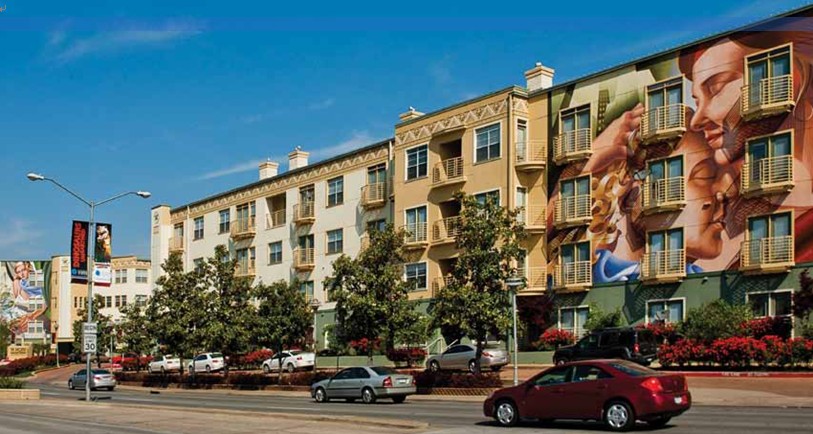
While making presentations across Texas, Real Estate
Center researchers frequently are aware of high-networth
investors in the audience. These people may
live in New York City, Miami or San Diego, but they invest in
Texas real estate.
Why do investors find Texas so attractive?
Let us count the reasons:
(1) Texas is leading the United
States in the current economic recovery,
(2) Texas' economy is
big and growing,
(3) Texas' economy is profitable,
(4) Texas has
a growing population,
(5) Texas' economy is an international
economy,
(6) the tax burden is less in Texas,
(7) Texas has an affordable
housing sector,
(8) Texans have entrepreneurial spirit,
and
(9) Texans are mobile.
1.Texas Leading Nation in Economic Recovery
The Great Recession ended in June 2009, according
to the Business Cycle Dating Committee of the
National Bureau of Economic Research. The committee
noted that "a trough in business activity
occurred in the U.S. economy in June 2009. The
trough marks the end of the recession that began
in December 2007 and the beginning of an expansion."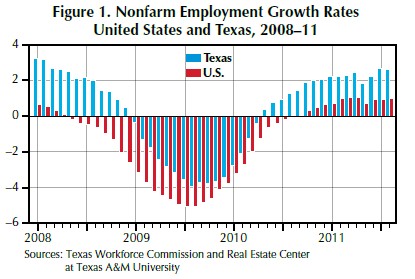
The Texas economy suffered less in terms of lost jobs and
outputs in the Great Recession than the nation as a whole
(Figure 1). The duration of the recession, measured by the number
of months of job losses, was shorter for Texas while the
intensity, measured by the highest job loss rate in the trough
month, was smaller for Texas than for the nation.
While the U.S. economy experienced its first month of
job losses in May 2008, Texas continued to create jobs for
eight more months, until January 2009 (Figure 1). The state's
economy posted job losses for 16 months, from January 2009
to April 2010.The largest year-on-year annual job loss rate for the United States was 5.1 percent in August 2009;
it was 4 percent for Texas that month.
The state's private sector suffered 17 months of job losses
with a trough of 5 percent job loss in August 2009 compared
with 28 months of job losses and a trough of 5.9 percent in
June 2009 for the nation (Figure 2). 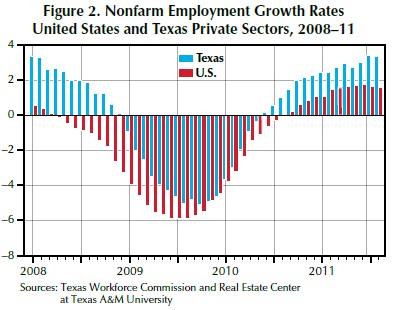
Academics and policy makers will be debating the
causes of the Great Recession for many years. Increases
in the Federal funds rate from 1 percent in 2003
to 5.2 percent in 2007, the increase in international crude
oil prices from $20 per barrel in 2001 to more than $130 per
barrel in 2008, the housing price bubble, misguided macroeconomic
policies, and the collapse of the U.S. financial system
have all been suggested.
Whatever the causes, consumers and producers responded to
the recession by postponing their investment and consumption
plans and waiting for signs of economic improvements. After
all, past economic recessions and depressions have ended in periods
of economic recovery, and the recent recession, no matter
how deep, is not an exception.
The postponement of investment and consumption has
created pent-up demand for goods, services and quality investments,
not just for distressed properties. In the short run,
meeting this demand for goods and services can lead to a consumption
boom, resulting in more investments in various parts
of the U.S. economy. If this leads to more employment, that
is, if employers increase output by employing more people,
then the short-run gains in the economy can lead to economic
growth in the long term.
Several indicators suggest that Texas is a promising region
for more investment, economic growth, and higher profitability
thanks to a combination of favorable human resources,
natural resources and its legal and policy environment. The
state's economy proved resilient in the Great Recession, and
now is leading the U.S. economic recovery. From August
2010 to August 2011, the U.S. economy added 1,282,000 jobs,
271,400 of which, or 21.1 percent, were generated in Texas
(Table 1).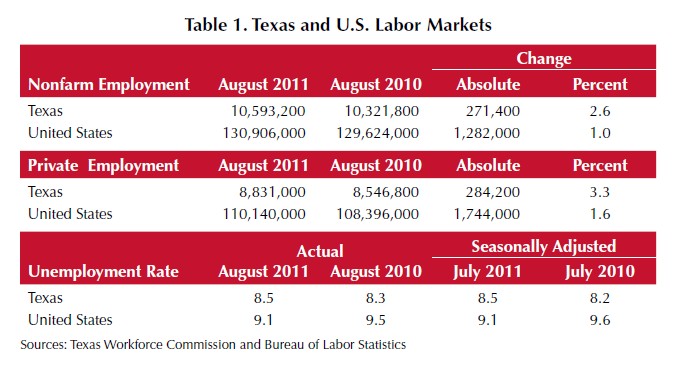
2.Texas' Economy is Big and Getting Bigger
With a gross domestic product (GDP) of more
than $1.2 trillion, Texas' economy was the 14th
largest in the world in 2010 (Table 2). It was the
second largest economy in the nation in 2010,
larger than New York's (Table 3). The state's GDP
accounted for 8.3 percent of U.S. GDP compared
with 13.1 percent for California and 8 percent for New York.
A growing economy offers more job opportunities and
attracts more population, leading to further growth in the
regional economy. By offering more investment opportunities,
a growing economy can further promote growth and development.
Revenues generated by a growing economy enable local
and state government to impose lower taxes.
Texas' share of U.S. GDP increased from 7.3 percent in 1997
to 8.3 percent in 2010 (Table 4). The state's share of total personal
income (wages, salaries, interest and dividend incomes)
generated in the U.S. increased from 6.7 percent to 7.9 percent
during that period (Table 5).
Higher output growth rates mean more jobs. Texas' share of
the nation's nonfarm employment increased from 7 percent in
August 1997 to 8.1 percent in August 2009 (Table 6).
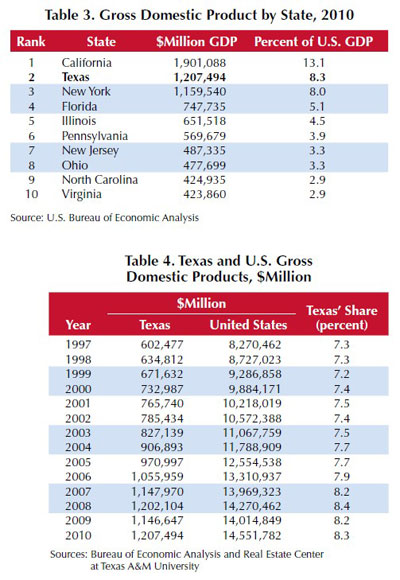
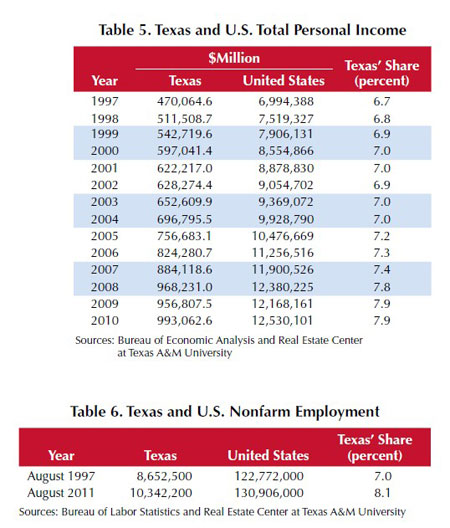
3.Texas' Economy is Profitable
An economy's profitability on a macro level can
be measured in terms of a macro profit margin.
Private sector GDP consists of compensation of
employees, taxes and subsidies, and gross operating
surplus (profits). The percentage of private sector GDP accounted for by gross operating surplus is an important
indicator of profitability of an economy.
In 2009, gross operating surplus in Texas
accounted for 40 percent of the state's private
sector GDP compared with a national average
of 37.5 percent (Table 7). This means Texas
businesses are more profitable.
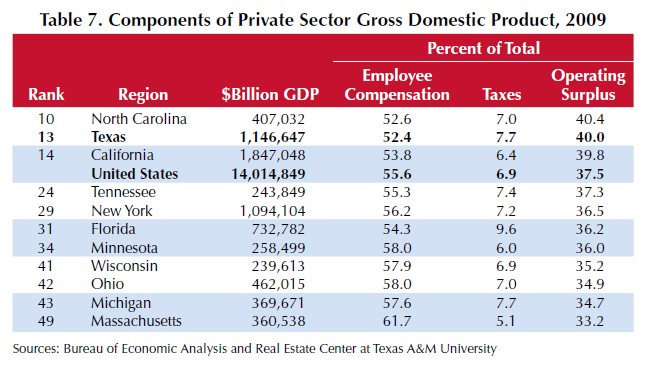
4.Texas' Population is Growing
A growing population, particularly
if well educated and
sporting an entrepreneurial
spirit, is an important part of the
economic infrastructure. On the
demand side, a growing population
boosts the need for goods and services,
especially housing units, which in turn leads to
more economic growth and higher profitability.
On the supply side, population is the source of labor inputs
for an economy. A growing population means the availability
of more labor inputs and fewer constraints on economic
activities.
The share of U.S. population
living in Texas has increased from
7.4 percent in 2000 to 8.1 percent
in 2009 (Table 8). Population studies
at the Real Estate Center have
shown that the annual growth
rate of the state's population is expected
to exceed the national average
in the foreseeable future. State
demographers have estimated that
the Texas population could grow
by 12 million from 2010 to 2030.
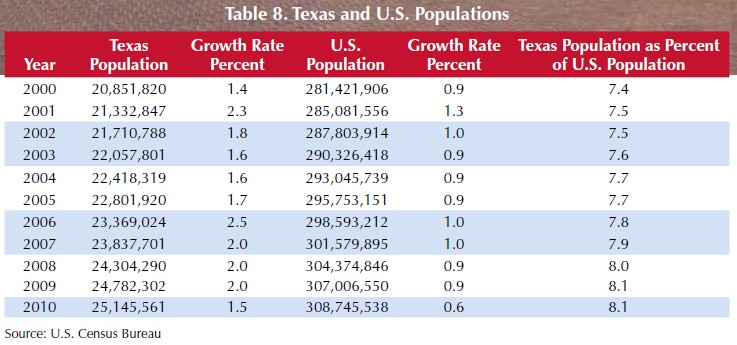
5.Texas' Economy is International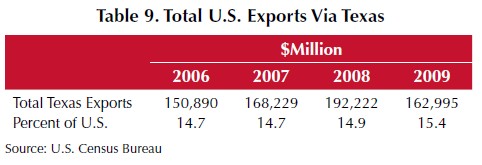
Texas is an important player in the nation's international
trade. Total exports via Texas in 2009
were nearly $163 billion, accounting for 15.4
percent of U.S. exports (Table 9).
The state alone exported more than $1 billion
to 25 countries in 2009. Mexico received 34.4
percent of Texas exports in 2009 followed by
Canada (8.5 percent) and China (5.5 percent).
6.Tax Burden is Less in Texas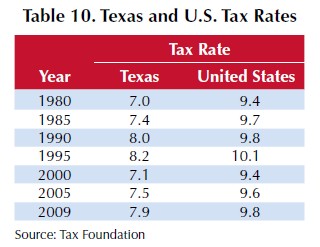
In 2009, state and local taxes paid by Texans accounted
for 7.9 percent of the state's per capita
income, compared with 9.8 percent for the nation
(Table 10).
7.Texas Has Affordable Housing
The average price of an owner-occupied housing
unit in Texas in 2009 was $125,800, about
68 percent of the national average (Table 11).
Affordable housing is an important factor in
attracting population to the state and expanding
the state's economy. The lower cost of living
allows wages to be lower, which helps Texas
businesses remain globally competitive.
8.Texans Have Entrepreneurial Spirit
New business creation and expansion of existing
businesses through innovation and creativity
drive economic growth. The percentage of
adult, nonbusiness owners who start a business
each month is a significant measure of entrepreneurial
activity. Another key measure is
the number of entrepreneurs per 1,000 adults
(Table 12).
According to the Kauffman Index of Entrepreneurial Activity,
Texas ranked tenth in entrepreneurial activity (400 per
Table 11. Median Value of Owner-Occupied 100,000 adults) in 2010 compared with 340 for the nation.
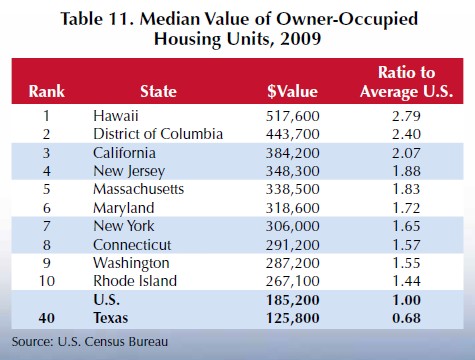

9.Texans are Mobile
Free movement of labor and capital not constrained
by language and cultural barriers in
various regions of the U.S. economy promotes
balanced economic growth and development.
One measure of labor mobility is the percentage
of people one year or older who lived in a different
house in the United States one year ago.
In 2009, about
17.4 percent of
Texans one year
and older lived
in a different
house one year
ago compared
with 14.9 percent
for the nation
(Table 13).
High mobility makes it easier for people to move away from
places with fewer economic opportunities to places where opportunities
are greater.
Texas is Built for Business
Texas is an attractive place for real estate investors. It works hard
to stay "business friendly," and the state's economic environment
supports businesses as they compete in the global economy.
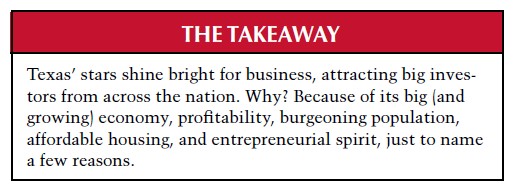
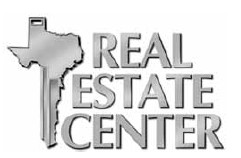
| MAYS BUSINESS SCHOOL | |
| Texas A&M University | http://recenter.tamu.edu |
| 2115 TAMU | 979-845-2031 |
| College Station, TX 77843-2115 | |
Advisory Committee
Joe Bob McCartt, Amarillo, chairman; , Mario A. Arriaga, Spring, vice chairman; Mona R. Bailey, North Richland Hills; James Michael Boyd, Houston;
Russell Cain, Fort Lavaca; Jacquelyn K. Hawkins, Austin; Kathleen McKenzie Owen, Pipe Creek; Kimberly Shambley, Dallas; Ronald C. Wakefield, San Antonio;
and Avis Wukasch, Georgetown, ex-officio representing the Texas Real Estate Commission.
Tierra Grande (ISSN 1070-0234) is published quarterly by the Real Estate Center at Texas A&M University, College Station, Texas 77843-2115. Subscriptions
are free to Texas real estate licensees. Other subscribers, $20 per year. Views expressed are those of the authors and do not imply endorsement by the
Real Estate Center, Mays Business School or Texas A&M University. The Texas A&M University System serves people of all ages, regardless of
socioeconomic level, race, color, sex, religion, disability or national origin. Photography/Illustrations: Robert Beals II, pp. 1, 4, 6.


